 JUST ONE COOKBOOK ESSENTIAL JAPANESE RECIPES
JUST ONE COOKBOOK ESSENTIAL JAPANESE RECIPES  RECIPES + PHOTOGRAPHY NAMIKO CHEN
RECIPES + PHOTOGRAPHY NAMIKO CHEN  JUST ONE COOKBOOK SERIES Copyright 2013 by Namiko Chen ( www.justonecookbook.com ) Photographs Copyright 2013 by Namiko Chen eBook Design by Divya Yadava ( www.divyayadava.com ) Published in eBook format by eBookIt.com http://www.eBookIt.com ISBN-13: 978-1-4566-2144-5 All Rights Reserved. No part of this publication may be copied, shared, or republished without express written permission of the author. Please visit www.justonecookbook.com for more recipes. An eBook is meant to be the personal property of the purchaser. Feel free to share a recipe with family or friends, but it is a copyright and purchase agreement violation to forward the entire book to another person or to post a recipe in full online or otherwise.
JUST ONE COOKBOOK SERIES Copyright 2013 by Namiko Chen ( www.justonecookbook.com ) Photographs Copyright 2013 by Namiko Chen eBook Design by Divya Yadava ( www.divyayadava.com ) Published in eBook format by eBookIt.com http://www.eBookIt.com ISBN-13: 978-1-4566-2144-5 All Rights Reserved. No part of this publication may be copied, shared, or republished without express written permission of the author. Please visit www.justonecookbook.com for more recipes. An eBook is meant to be the personal property of the purchaser. Feel free to share a recipe with family or friends, but it is a copyright and purchase agreement violation to forward the entire book to another person or to post a recipe in full online or otherwise.
INTRODUCTION  I learned almost everything I know about cooking Japanese food from my mother. When I was young, every evening, she would call me into the kitchen to cut veggies and help prep ingredients for dinner.
I learned almost everything I know about cooking Japanese food from my mother. When I was young, every evening, she would call me into the kitchen to cut veggies and help prep ingredients for dinner.
She would not actually let me do the cooking, but I soon began to develop my skills, prep after prep. Needless to say, prepping food wasnt my favorite thing to do growing up! At the time I didnt know this, but all the prep work my mother guided me through would not only come in handy later in my life; this knowledge she gave me would soon become essential to my life. When I left Japan at age twenty to attend college in the United States, I longed for one of my mothers home cooked Japanese meals. I soon realized that the only way to enjoy home cooked Japanese food was to cook it myself! Thanks to the time I had spent with my mom in the kitchen, night after night, I was able to create and enjoy a piece of home through cooking. My mom was the one who taught me the fundamentals of Japanese cooking, guiding me through the different cooking methods. When I actually started to cook, I knew how to prepare ingredients; the actual cooking part became easier as I spent years watching my mother work her magic.
I am now using all the tips and tricks she taught me to prepare home cooked Japanese meals for my husband, my son, my daughter and my friends here in the United States. Preparing Japanese recipes for my family and friends grew into sharing recipes on Just One Cookbook for two reasons. First, I wanted to create a place where all my recipes could live so I could pass them on to my children. My own mom never kept her recipes how I wish she did! The second reason I created Just One Cookbook was to share quick and simple recipes with my friends who wanted to make Japanese food at home, but didnt have much experience in the kitchen. In this Essential Japanese Recipes cookbook, I collected the most popular Japanese recipes from Just One Cookbook over the past 3 years. I hope youll enjoy these recipes as much as my family and readers do.
I want to thank the readers who inspired and encouraged me to create this cookbook. Youll find that these recipes are easy to prepare and the ingredients are rather easy to find. I hope as you prepare each appetizer, dish or dessert youll be pleasantly surprised by how delicious they taste. Happy Cooking!  FOUNDER + AUTHOR, www.justonecookbook.com INTERESTED IN LEARNING MORE ABOUT JAPANESE COOKING? VISIT US: WWW.JUSTONECOOKBOOK.COM
FOUNDER + AUTHOR, www.justonecookbook.com INTERESTED IN LEARNING MORE ABOUT JAPANESE COOKING? VISIT US: WWW.JUSTONECOOKBOOK.COM  CLICK BELOW TO FOLLOW! Facebook Twitter YouTube Google+ FeedBurner Pinterest
CLICK BELOW TO FOLLOW! Facebook Twitter YouTube Google+ FeedBurner Pinterest
BASICS + PANTRY DASHI Used in many Japanese recipes, this stock is made from kombu (dried kelp), bonito flakes (shaved skipjack tuna), sardine, or a combination of all or two of them which creates a unique umami flavor. YIELD: 3 1/2 CUPS PREP: 5 MIN COOK: 35 MIN INGREDIENTS 0.7 oz (20 g) kombu 3 cups (30 g) loosely packed katsuobushi (dried bonito flakes) - omit for vegetarian/vegan Kombu Dashi 4 cups (1000 ml) water (or 8 cups - see Note) Notes: If you dont need strong dashi flavor, you can replace 4 cups of water with 8 cups. If you are not using dashi right away, save it in a bottle and keep in the refrigerator for 3-7 days or in the freezer for 3 weeks.
STEPS Gently clean the kombu with a damp cloth, without removing the white powdery umami substances. Make a couple of slits on the kombu. Put the kombu and water in a saucepan and soak for 2-3 hours (at least 30 minutes). Slowly bring to a boil over medium low heat. Just before boiling, turn off the heat and remove the kombu. If you dont remove the kombu, the dashi will become slimy and bitter.
For vegetarian Kombu Dashi , strain the dashi through a sieve lined with a paper towel set over a bowl. For regular Dashi , let the dashi cool a bit. Add the katsuobushi and bring it to a boil again. Once the dashi is boiling, reduce the heat and simmer for 30 seconds. Turn off the heat and let the katsuobushi sink to the bottom, about 10 minutes. Strain the dashi through a sieve lined with a paper towel set over a bowl.
Gently twist and squeeze the paper towel to release the extra dashi into the bowl. CLICK! TO VIEW PHOTO INSTRUCTIONS DAIRY FREE VEGAN SOY FREE GLUTEN FREE  MISO SOUP Most Japanese meals are served with a bowl of miso soup and steamed rice. The secret to delicious miso soup is good dashi. Experiment and try adding seasonal ingredients to miso soup! SERVES: 3-4 PREP: 5 MIN COOK: 5 MIN INGREDIENTS 3 cups dashi 3 Tbsp. miso* 6 oz silken tofu or soft tofu , drained, cut into 1/2 (1 cm) cubes 2 tsp. dried ready-to-use wakame (seaweed), rehydrated green onion/scallion , finely sliced Notes: For vegetarian miso soup, use kombu dashi.
MISO SOUP Most Japanese meals are served with a bowl of miso soup and steamed rice. The secret to delicious miso soup is good dashi. Experiment and try adding seasonal ingredients to miso soup! SERVES: 3-4 PREP: 5 MIN COOK: 5 MIN INGREDIENTS 3 cups dashi 3 Tbsp. miso* 6 oz silken tofu or soft tofu , drained, cut into 1/2 (1 cm) cubes 2 tsp. dried ready-to-use wakame (seaweed), rehydrated green onion/scallion , finely sliced Notes: For vegetarian miso soup, use kombu dashi.
For quick dashi, put 1 1/4 tsp. dashi powder (or 1 dashi packet) in 3 cups water. Each brand or kind of miso has different level of saltiness; therefore, add miso 1 Tbsp. at a time and taste the soup before you add more miso. *Use gluten-free miso to make this recipe gluten-free. STEPS In a medium saucepan, bring dashi to a boil and turn off the heat.
Put 1 Tbsp. of miso in a ladle and scoop some dashi from the saucepan. Blend it until it is thoroughly mixed and pour back to the saucepan. Continue this process until miso is all used. Usually for each cup of dashi, you will need about 1 Tbsp. of miso.
Add tofu to the soup and stir gently without breaking the tofu. Return to a slight simmer until heated through. Be careful not to boil the miso soup because miso will lose flavor. Place the wakame and green onion in each bowl. Pour miso soup into the bowls. CLICK! TO VIEW PHOTO INSTRUCTIONS GLUTEN FREE DAIRY FREE VEGETARIAN/VEGAN  STEAMED RICE The Japanese consider rice as the main course and most important part of the meal.
STEAMED RICE The Japanese consider rice as the main course and most important part of the meal.
Enjoy tasty steamed rice without using a rice cooker. SERVES: 2-3 PREP: 5 MIN COOK: 15 MIN INGREDIENTS 1 cup premium Japanese short grain rice 1 1/4 cups (300 ml) water Note: A heavy-bottom pot with a tight-fitting lid is recommended. STEPS Put rice in a large bowl. Gently wash the rice in a circular motion and discard the water. Repeat this process about 4-5 times until the water becomes almost translucent. Let the rice soak in water for 30 minutes.
Next page
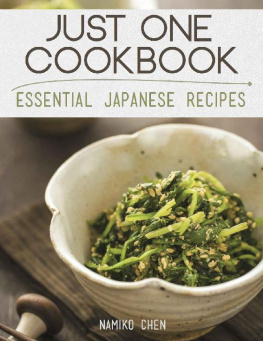
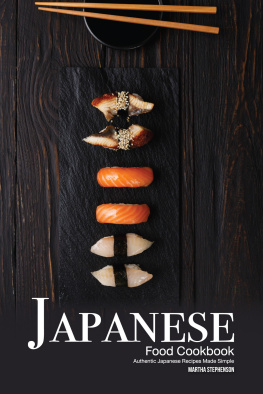

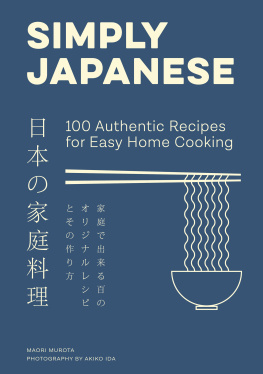
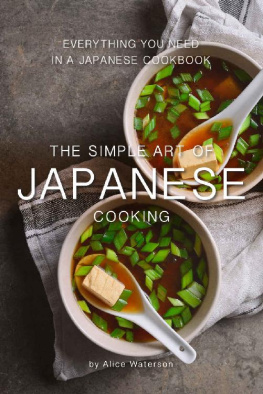
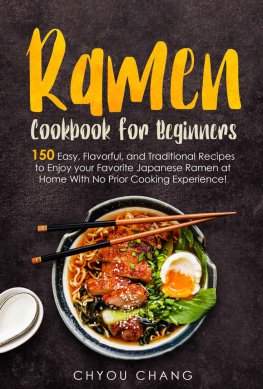
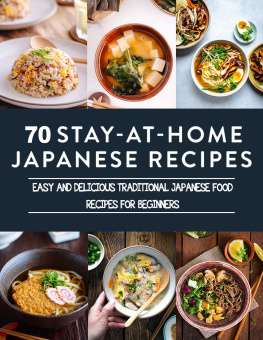

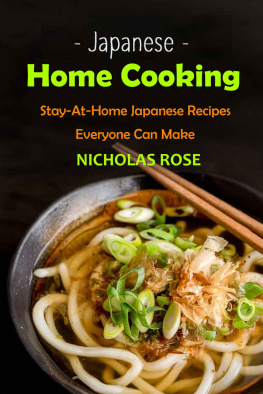

 JUST ONE COOKBOOK ESSENTIAL JAPANESE RECIPES
JUST ONE COOKBOOK ESSENTIAL JAPANESE RECIPES  RECIPES + PHOTOGRAPHY NAMIKO CHEN
RECIPES + PHOTOGRAPHY NAMIKO CHEN  JUST ONE COOKBOOK SERIES Copyright 2013 by Namiko Chen ( www.justonecookbook.com ) Photographs Copyright 2013 by Namiko Chen eBook Design by Divya Yadava ( www.divyayadava.com ) Published in eBook format by eBookIt.com http://www.eBookIt.com ISBN-13: 978-1-4566-2144-5 All Rights Reserved. No part of this publication may be copied, shared, or republished without express written permission of the author. Please visit www.justonecookbook.com for more recipes. An eBook is meant to be the personal property of the purchaser. Feel free to share a recipe with family or friends, but it is a copyright and purchase agreement violation to forward the entire book to another person or to post a recipe in full online or otherwise.
JUST ONE COOKBOOK SERIES Copyright 2013 by Namiko Chen ( www.justonecookbook.com ) Photographs Copyright 2013 by Namiko Chen eBook Design by Divya Yadava ( www.divyayadava.com ) Published in eBook format by eBookIt.com http://www.eBookIt.com ISBN-13: 978-1-4566-2144-5 All Rights Reserved. No part of this publication may be copied, shared, or republished without express written permission of the author. Please visit www.justonecookbook.com for more recipes. An eBook is meant to be the personal property of the purchaser. Feel free to share a recipe with family or friends, but it is a copyright and purchase agreement violation to forward the entire book to another person or to post a recipe in full online or otherwise. I learned almost everything I know about cooking Japanese food from my mother. When I was young, every evening, she would call me into the kitchen to cut veggies and help prep ingredients for dinner.
I learned almost everything I know about cooking Japanese food from my mother. When I was young, every evening, she would call me into the kitchen to cut veggies and help prep ingredients for dinner. FOUNDER + AUTHOR, www.justonecookbook.com INTERESTED IN LEARNING MORE ABOUT JAPANESE COOKING? VISIT US: WWW.JUSTONECOOKBOOK.COM
FOUNDER + AUTHOR, www.justonecookbook.com INTERESTED IN LEARNING MORE ABOUT JAPANESE COOKING? VISIT US: WWW.JUSTONECOOKBOOK.COM  CLICK BELOW TO FOLLOW! Facebook Twitter YouTube Google+ FeedBurner Pinterest
CLICK BELOW TO FOLLOW! Facebook Twitter YouTube Google+ FeedBurner Pinterest MISO SOUP Most Japanese meals are served with a bowl of miso soup and steamed rice. The secret to delicious miso soup is good dashi. Experiment and try adding seasonal ingredients to miso soup! SERVES: 3-4 PREP: 5 MIN COOK: 5 MIN INGREDIENTS 3 cups dashi 3 Tbsp. miso* 6 oz silken tofu or soft tofu , drained, cut into 1/2 (1 cm) cubes 2 tsp. dried ready-to-use wakame (seaweed), rehydrated green onion/scallion , finely sliced Notes: For vegetarian miso soup, use kombu dashi.
MISO SOUP Most Japanese meals are served with a bowl of miso soup and steamed rice. The secret to delicious miso soup is good dashi. Experiment and try adding seasonal ingredients to miso soup! SERVES: 3-4 PREP: 5 MIN COOK: 5 MIN INGREDIENTS 3 cups dashi 3 Tbsp. miso* 6 oz silken tofu or soft tofu , drained, cut into 1/2 (1 cm) cubes 2 tsp. dried ready-to-use wakame (seaweed), rehydrated green onion/scallion , finely sliced Notes: For vegetarian miso soup, use kombu dashi. STEAMED RICE The Japanese consider rice as the main course and most important part of the meal.
STEAMED RICE The Japanese consider rice as the main course and most important part of the meal.